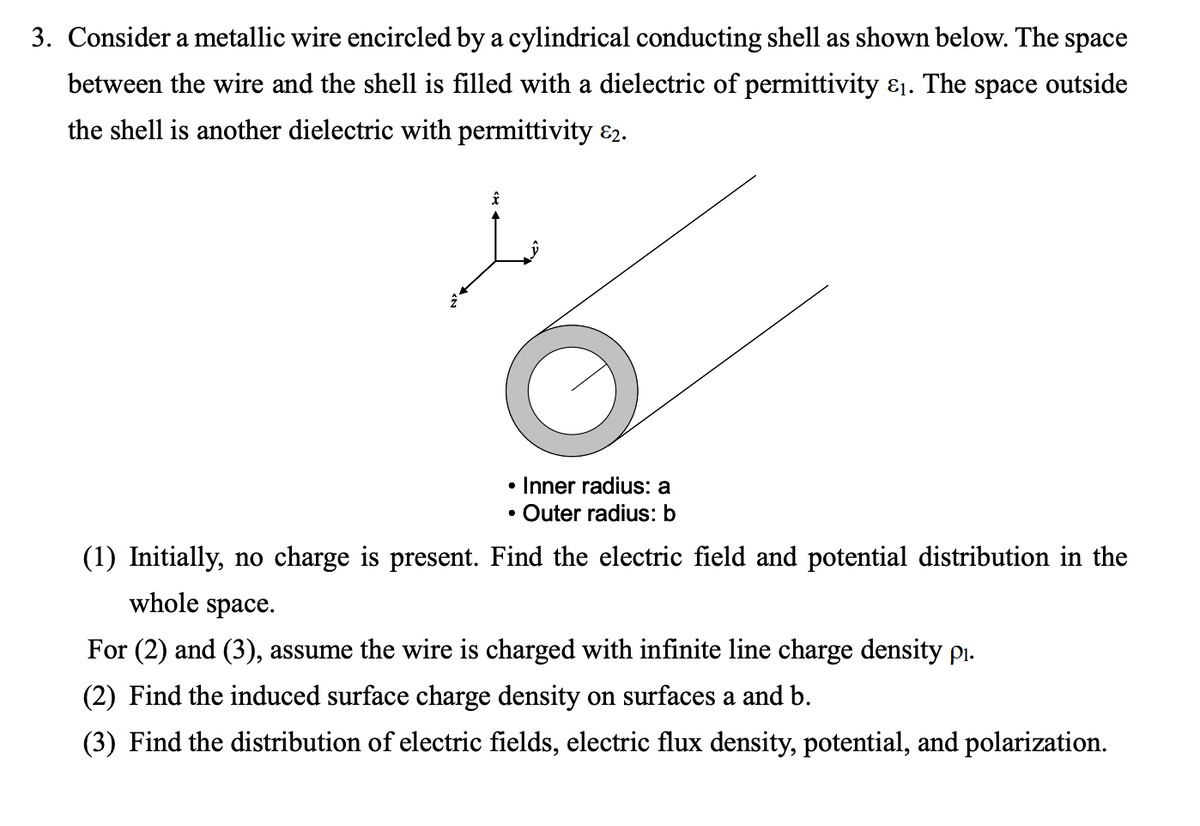3. Consider a metallic wire encircled by a cylindrical conducting shell as shown below. The space between the wire and the shell is filled with a dielectric of permittivity ɛ1. The space outside the shell is another dielectric with permittivity &2. • Inner radius: a • Outer radius: b (1) Initially, no charge is present. Find the electric field and potential distribution in the whole space. For (2) and (3), assume the wire is charged with infinite line charge density pı. (2) Find the induced surface charge density on surfaces a and b. (3) Find the distribution of electric fields, electric flux density, potential, and polarization.
3. Consider a metallic wire encircled by a cylindrical conducting shell as shown below. The space between the wire and the shell is filled with a dielectric of permittivity ɛ1. The space outside the shell is another dielectric with permittivity &2. • Inner radius: a • Outer radius: b (1) Initially, no charge is present. Find the electric field and potential distribution in the whole space. For (2) and (3), assume the wire is charged with infinite line charge density pı. (2) Find the induced surface charge density on surfaces a and b. (3) Find the distribution of electric fields, electric flux density, potential, and polarization.
Introductory Circuit Analysis (13th Edition)
13th Edition
ISBN:9780133923605
Author:Robert L. Boylestad
Publisher:Robert L. Boylestad
Chapter1: Introduction
Section: Chapter Questions
Problem 1P: Visit your local library (at school or home) and describe the extent to which it provides literature...
Related questions
Question

Transcribed Image Text:3. Consider a metallic wire encircled by a cylindrical conducting shell as shown below. The space
between the wire and the shell is filled with a dielectric of permittivity ɛ1. The space outside
the shell is another dielectric with permittivity E2.
• Inner radius: a
• Outer radius: b
(1) Initially, no charge is present. Find the electric field and potential distribution in the
whole space.
For (2) and (3), assume the wire is charged with infinite line charge density pi.
(2) Find the induced surface charge density on surfaces a and b.
(3) Find the distribution of electric fields, electric flux density, potential, and polarization.
Expert Solution
This question has been solved!
Explore an expertly crafted, step-by-step solution for a thorough understanding of key concepts.
This is a popular solution!
Trending now
This is a popular solution!
Step by step
Solved in 4 steps

Knowledge Booster
Learn more about
Need a deep-dive on the concept behind this application? Look no further. Learn more about this topic, electrical-engineering and related others by exploring similar questions and additional content below.Recommended textbooks for you

Introductory Circuit Analysis (13th Edition)
Electrical Engineering
ISBN:
9780133923605
Author:
Robert L. Boylestad
Publisher:
PEARSON

Delmar's Standard Textbook Of Electricity
Electrical Engineering
ISBN:
9781337900348
Author:
Stephen L. Herman
Publisher:
Cengage Learning

Programmable Logic Controllers
Electrical Engineering
ISBN:
9780073373843
Author:
Frank D. Petruzella
Publisher:
McGraw-Hill Education

Introductory Circuit Analysis (13th Edition)
Electrical Engineering
ISBN:
9780133923605
Author:
Robert L. Boylestad
Publisher:
PEARSON

Delmar's Standard Textbook Of Electricity
Electrical Engineering
ISBN:
9781337900348
Author:
Stephen L. Herman
Publisher:
Cengage Learning

Programmable Logic Controllers
Electrical Engineering
ISBN:
9780073373843
Author:
Frank D. Petruzella
Publisher:
McGraw-Hill Education

Fundamentals of Electric Circuits
Electrical Engineering
ISBN:
9780078028229
Author:
Charles K Alexander, Matthew Sadiku
Publisher:
McGraw-Hill Education

Electric Circuits. (11th Edition)
Electrical Engineering
ISBN:
9780134746968
Author:
James W. Nilsson, Susan Riedel
Publisher:
PEARSON

Engineering Electromagnetics
Electrical Engineering
ISBN:
9780078028151
Author:
Hayt, William H. (william Hart), Jr, BUCK, John A.
Publisher:
Mcgraw-hill Education,